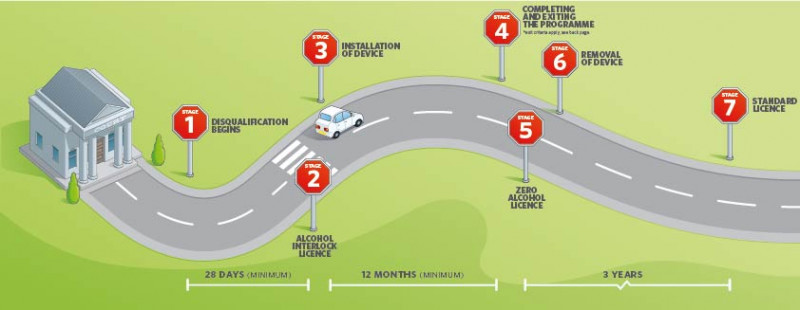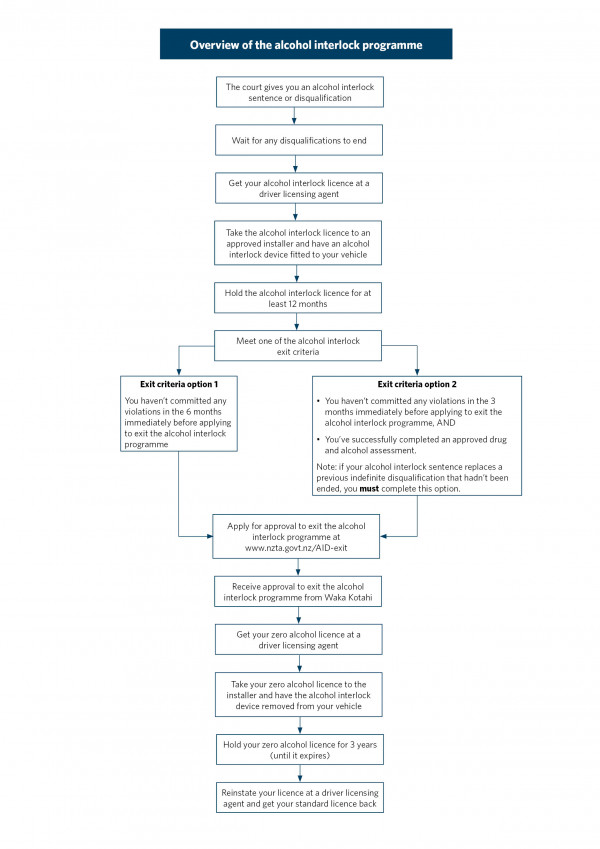Find out how to get an alcohol interlock licence, how to have an alcohol interlock device fitted to your vehicle and how to exit the alcohol interlock programme.

If you’re convicted by the courts (under section 65AC of the Land Transport Act 1998) for driving offences involving alcohol, you’ll be given an alcohol interlock disqualification of 28 days or more.
Any driver licence card you held before your disqualification is cancelled and you won’t be entitled to a limited licence.
At the end of the alcohol interlock disqualification, you’re still disqualified from driving until you’ve been issued with an alcohol interlock licence.
If you have any other disqualifications or suspensions, you’ll have to wait for them to end too before you can get an alcohol interlock licence.
After any disqualifications and/or suspensions have ended, you can apply to reinstate your licence at any driver licensing agent.
You’ll be issued with an alcohol interlock licence, which means you’ll only be entitled to drive vehicles fitted with an approved alcohol interlock device.
Find out more about getting an alcohol interlock licence
You’ll need to follow step 3 before you can start to drive again.
An alcohol interlock is a breath testing device that’s wired into a vehicle’s starting system. Before the vehicle can start, the driver must blow into the device. If any alcohol is detected on your breath, the vehicle won’t start.
There are two approved providers of alcohol interlocks who have installers all over New Zealand. These are:
You can also check our map of all the installers in New Zealand to find an installer near you.
You’ll need to pay an installation fee and a monthly lease fee to the installer. These fees may vary. The approved provider/installer may tell you what the fees will be.
Waka Kotahi NZ Transport Agency may grant you subsidy assistance for some alcohol interlock costs if your financial circumstances qualify you for a subsidy.
Find out if you're eligible for an alcohol interlock subsidy
You must breathe into the alcohol interlock before starting the vehicle. The alcohol interlock analyses the breath sample and if alcohol is detected the vehicle won’t start.
You also need to provide a breath sample at random times while the vehicle is in use (this is called a rolling retest).
Make sure you take every test the device requires, including re-tests. If you don't take a test it can affect your assessment when you apply for approval to exit this stage of the programme.
Data relating to the vehicle use, alcohol readings and violations are recorded by the device. Each month the vehicle must be taken to the installer for servicing and to have the data downloaded. If the vehicle isn’t taken to the installer for a scheduled service and data download, then the interlock device will prevent the vehicle from starting until the installer services the alcohol interlock.
Make sure you're familiar with how you alcohol interlock works. You can download a user manual from your provider's website.
Draeger Interlock XT user guide(external link)
Smart Start Interlocks user manual(external link)
Before you can exit this stage you must have held your alcohol interlock licence for at least 12 months.
While you have the alcohol interlock device you must:
You also need to meet one of the following criteria:
Option 1
Option 2
Find an approved drug and alcohol assessment centre in your area
If your alcohol interlock sentence replaces a previous indefinite disqualification that hadn't been ended, then you must meet option 2 above.
Breaching any of the alcohol interlock licence conditions defined in the Land Transport (Alcohol Interlock) Regulations 2012 is a violation.
This means that if you do any of the following during the period being assessed (ie three months or six months) we won't give you approval to exit the alcohol interlock stage.
When you’re ready to exit the alcohol interlock stage of the programme, and you've met the criteria above, you need to get your AID provider to download a reading for you.
Immediately after this download, apply online for approval to exit the programme.
Apply online for approval to exit the alcohol interlock programme
You can supply additional evidence with your application if you wish.
Once we’ve granted you approval to exit the programme, you can move to step 6.
After you get approval to exit the programme, you can apply to get a zero alcohol licence.
Find out more about getting a zero alcohol licence
You’re still subject to the conditions of your alcohol interlock licence (ie you can only drive vehicles fitted with an alcohol interlock device) until you’ve got your zero alcohol licence.
Take your zero alcohol licence to the approved provider/installer. Your zero alcohol licence lets the installer know that you’re approved to exit the alcohol interlock stage of the programme. The installer will then remove the alcohol interlock from your vehicle.
After the alcohol interlock has been removed from your vehicle, you’ll still be subject to a zero alcohol limit for the three years that you hold your zero alcohol licence. This means that if you have even one drink and then drive, you can be charged with drink driving and disqualified.
You’ll need to hold your zero alcohol licence for three years, and then it will expire. You can then apply to reinstate your licence at any driver licensing agent and be issued with a standard licence.
You can apply for your driver licence at any driver licensing agent.
You'll need to:
If you were disqualified for 12 months or less the fee is $31.30.
If you were disqualified for more than 12 months, you'll also need to pass the appropriate tests and pay test fees.
You'll have to pass a theory test and a practical test for a car. Your application fee is $136.90.
Your application fee includes 2 theory tests and 2 practical tests, if you need them.
If you need to sit 3 tests or more of either test type, you'll pay a fee for each test.
| Test type | Test fee for each test from 3rd attempt |
| Theory test | $54.60 |
| Full practical test | $71.90 |
If you have a learner licence, the application fee is $77.00. You only have to pass a theory test.
If you have a restricted licence, the application fee is $163.60. You have to pass a theory test and a restricted licence practical test.
If you need to sit 3 tests or more of either test type, you'll pay a fee for each test.
| Test type | Test fee for each test from 3rd attempt |
| Theory test | $54.60 |
| Restricted practical test | $102.80 |
If you need to change or cancel your test, please do it as far in advance as possible. Then another person can book the test slot.
When you change or cancel your test, you may need to pay a fee.
Changing a test for a car licence
If you had a heavy vehicle licence (classes 2–5), you only sit a theory and a practical test for the highest class. For example, for a class 5 licence you just sit a theory and practical test for class 5.
You’ll pay the application fee of $31.30 and the theory test fee of $45.70 when you apply (total $77.00). When you’ve passed your theory test, you’ll pay the practical test fee of $59.90 to book your practical test.
It’s free to change, cancel or rebook your test. Please do it as far in advance as possible so someone else can book the test time.
You can complete an approved course instead of passing a practical test. You won’t have to pay the practical test fee.
You’ll have to pass a theory and practical test for a motorcycle. If you also want to get your car licence back, you’ll need to sit both sets of tests.
You’ll pay the application fee of $31.30 and the theory test fee of $45.70 when you apply (total $77.00). When you’ve passed your theory test, you’ll pay the practical test fee of $59.90 to book your practical test.
It’s free to change, cancel or rebook your test. Please do it as far in advance as possible so someone else can book the test time.
If you’ve passed a theory test but still have to sit a practical test, you’ll get a licence with a supervisor condition.
The supervisor condition will remain until you’ve passed your practical test.
A supervisor is a person who:
If you’re getting a motorcycle licence back, you’ll get a motorcycle learner licence. You’ll need to follow the motorcycle learner conditions until you’ve passed your practical test.
The application fee to move from an alcohol interlock licence to a zero alcohol licence is $37.30.
The application fee to reinstate your licence after you’ve had your zero alcohol licence for 3 years is $48.00.
Can I supply my own alcohol interlock?
No. If you're subject to the conditions of an alcohol interlock licence, then you must use an approved device, provided and fitted by an approved installer.
If I have an alcohol interlock device fitted, can someone else drive my vehicle?
Yes. Another licensed driver can drive your vehicle but they must comply with all of the alcohol interlock requirements, eg they must complete a breath check to start the vehicle. Their results and any violations will be recorded in your assessment data, and may affect your ability to exit the alcohol interlock programme.
Can I keep the alcohol interlock afterwards?
Yes. Check with the approved provider who can tell you the options for continuing to lease the alcohol interlock or buying it outright.
Can I apply for a different type of licence when I have an alcohol interlock licence?
You can apply to renew, replace or reinstate your alcohol interlock licence. However, you’re not entitled to a limited licence, or to get any new licence classes or endorsements.
Can I get a subsidy if my circumstances change?
If your circumstances change partway through your sentence and you met the financial eligibility criteria, you may be eligible to have the rest of your alcohol interlock costs subsidised.
More information about the alcohol interlock subsidy(external link)
Can I use the alcohol interlock device as a breath test?
No. If you’re blowing into the device you should have the intention to drive. All data will be recorded and included in your assessment when you apply to exit the alcohol interlock programme.
Can a substance other than alcohol make me fail a test?
Yes, some substances like sanitiser, mouthwash or food could cause you to fail a test. You should always take any re-tests that your device requires. Check your device’s manual to find out what to do when this happens.
Draeger Interlock XT user guide(external link)(external link)
Smart Start Interlocks user manual(external link)
What should I do when my vehicle is serviced?
If your mechanic needs to start your vehicle when it’s being serviced or repaired, they’ll need to blow into the device to get it started. We recommend you get something in writing from the garage to confirm it was being serviced at the time.
Download Factsheet 58: Alcohol interlocks [PDF, 350 KB]
